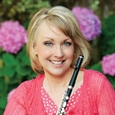.jpg) Vibrato is a critical component of a beautiful tone. Sometimes in the obsession to improve sound, howver, we concentrate on vibrato instead of other fundamental components of tone that should be in place first.
Vibrato is a critical component of a beautiful tone. Sometimes in the obsession to improve sound, howver, we concentrate on vibrato instead of other fundamental components of tone that should be in place first.
Embouchure
A good embouchure is one that directs the airstream in an efficient way to the headjoint. Remember that the piccolo is much smaller than the flute, but the embouchure does not have to be tighter. Place the piccolo slightly higher on the lower lip than you would the flute (on the pink part of the lip) to compensate for the smaller size of the embouchure hole. Make sure that the corners of the lips are not overly tight. Think of the center of the lips coming forward slightly as if you are blowing a kiss to someone across the room. The upper lip is not held tightly to the top teeth as this forward positioning fosters a magic cushion of space between the upper lip and front teeth.
Free Flowing Airstream
In order to cultivate resonance in the sound, the airstream must be free flowing. Make sure that the tongue, throat, and lips are not an impediment to the airstream. Remember that the throat is only a conduit for the air to get from the lungs to the instrument where the vibration is produced at the striking edge of the headjoint (backwall). Think of separating the vocal folds, much like panting, to keep a relaxed and open feeling in the throat. This is critical for good vibrato production. Another image that works well is thinking of blowing warm air. Blow into your hands as if warming them on a chilly day by naturally using an open HAH syllable. This keeps the throat relaxed and open. Keep the tongue muscles relaxed and in the syllable formation of de, gee, ta, or ga. Any of these choices will keep the tongue from riding too high in the mouth and impeding the airstream.
A teacher once said that a moving airstream is supported. This is true. The diaphragm, which is an involuntary muscle, is an integral part of breathing. It assists in inhalation provided the piccolo player takes a full body breath, and does not just fill the upper chest area. This support is necessary for the maximum efficiency of the airstream.
Make sure to not squeeze the lips together in order to create air speed as this produces the kind of tone that is usually thin, and the pitch can be quite sharp. The lips direct the air only. They do not make the tone; they shape the tone. The air is actually the medium that makes the tone.
I remind students of a garden hose analogy. The nozzle places the water on a certain plant just as the lips change direction for certain registers. The hose nozzle does not make the water come out, it only releases the water. The flow of water is created by the water pressure at the faucet (the faucet being analogous to breathing anatomy).
Think of directing the air forward to the bridge of the nose; this can result in a faster air speed (try this on lower notes). Likewise, to create a more resonant and mellow tone in the top octave, feel like the resonance is coming from the chest or even from the back of the head. This can give a more open sound which works especially well on high third octave sustained passages that require blend.
Physical Alignment
Strive for good upper body posture. Due to the piccolo’s small size, there is a tendency for players to hunch over when playing. Sit up tall and keep the head balanced on the spine. Be sure the chin does not jut forward like a turtle. Open the shoulder girdle and keep an expansive feeling between the shoulder blades. Without arching the lower back, keep the collarbone lifted naturally. Make sure there is no undue tension in the arms or hands. Tension anywhere in the upper body can translate into tongue or facial tension. I often think of my body as being rather like the case that holds a stereo speaker. It is the resonating chamber for the sound. (This may be an image younger players are not familiar with since ear buds are the most popular speaker today.)
Vibrato
Once these basics are in place, you are optimally positioned to hone in on vibrato. On the piccolo vibrato is produced the same way as on the flute. It is an oscillation created in the larynx. The artistic application of vibrato will be slightly different than on the flute. Your body knows how to create this oscillation since the sounds made in coughing, crying, laughing and singing are all created there as well. I have always loved to teach vibrato as a connected ha, ha, ha sound. First speak the syllables, and then connect them as you would in singing. Then take the consonant h sound out and continue singing and then try all of this through the instrument. Make sure that you understand the difference between vibrato speed vs. vibrato width. Speed refers to how many pulses of vibrato per beat. For example, most flutists and piccolo players work on counted vibrato exercises with a metronome, setting the metronome at quarter note = 60 and vibrating with groups of 3, then 4, then 5, and then 6 per click. Make sure to connect the pulses evenly without a bump or pulse that is jarring. Faster vibrato can give more intensity to the sound. Listen to the evolution of vibrato speeds through different recordings. Historically we seem to favor generally slower vibrato than what was in vogue at the turn of the 20th century. (This seems to be true of singers, violinists and flutists).
Vibrato width refers to the depth of the vibrato. For instance, I think it is very helpful to cultivate a very shallow vibrato, (just a hint of shimmer), a normal depth of vibrato, and a wider vibrato. All three styles are useful on a daily basis. A deep vibrato can add volume to the tone. Even though vibrato is thought to be a fluctuation of pitch both on the high side and the low side, I try to keep it on the lower side so as to not raise the pitch unintentionally. It helps to end notes, or release, on the high side of the vibrato so that the pitch does not sag.
In general, for piccolo, strive for a vibrato that is not intrusive on tutti passages (especially as the top voice on sustained chords, for example). I sometimes use very little vibrato on chords, which helps the blend, or a slower, deeper vibrato for adding just a little sonic interest. If playing a passage with an instrument that does not use vibrato, such as the clarinet, make sure not to vibrate too fast or you will not achieve a good blend.
Use your more creative speeds and widths on solo passages. Vibrato is not used on busy passages with many sixteenth notes as this will distort the tone and hurt projection. Dynamic levels and the resultant changes in both embouchure size and air pressure will affect vibrato speed as well. When playing very softly, the vibrato should not be too wide or it will place the “heart of an elephant in a mouse” as Trevor Wye said. Vibrato is a flexible artistic device that should constantly change depending on the requirements of the music.
Practice starting and stopping vibrato on a dime to achieve ultimate control. With a metronome set at quarter=60, alternate playing two beats of straight tone with two beats with vibrato (at varying speeds, 4 pulses, 5 pulses, 6 pulses per click) then back to two beats without vibrato. Check periodically that the other elements of good tone production are in place. Some students substitute a wide vibrato in place of a fast moving airstream, so it helps to work on long tones senza (without) vibrato to make sure these two concepts are indeed complimentary but separate.
Record practice sessions and listen to musicians other than flutists or piccolo players to expand your imagination for tonal possibilities of vibrato. I especially enjoy listening to violinists and sopranos since they are in the same tessitura as the piccolo. Stay flexible and ready to adjust, as a conductor may request a different vibrato style that what you have prepared. Œ.






